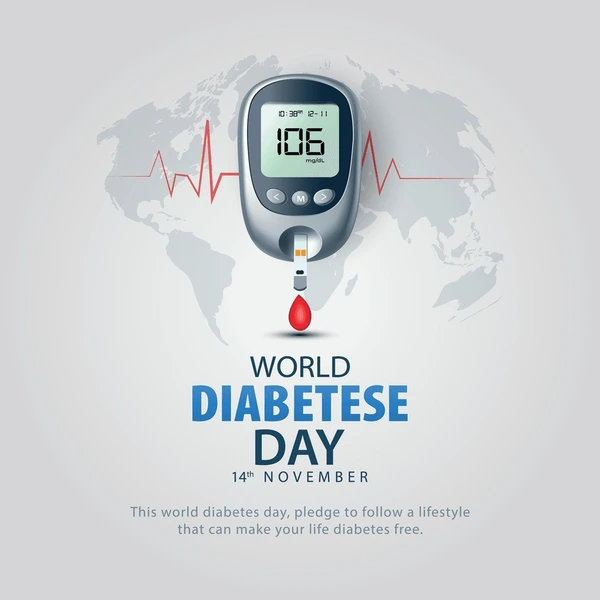Diabetes in the Caribbean: A Slow Emergency Hidden in Plain Sight

On World Diabetes Day, the Caribbean cannot afford to treat diabetes as a one day slogan. The region now carries one of the heaviest diabetes burdens in the world, and the numbers reveal a crisis that is deep, costly, and still growing. Across the Caribbean, the pattern repeats: high prevalence, frequent complications, and health systems that already struggle to cope with chronic disease. Small island developing states have been singled out in global health reports as having some of the highest adult diabetes rates anywhere. The numbers should stop the region in its tracks
Globally, hundreds of millions of adults live with diabetes, and that figure continues to rise each year. Projections suggest that by 2050, the number of people with diabetes worldwide could reach the high hundreds of millions. Many of these cases are type 2 diabetes, which is strongly linked to diet, physical inactivity, and broader social and economic conditions.
The Americas share heavily in that burden. Estimates for the Region of the Americas suggest that roughly 1 in 8 adults lives with diabetes. Within that regional picture, the Caribbean stands out for the wrong reasons, with prevalence in some countries approaching or exceeding 1 in 5 adults.
When the focus shifts to the North America and Caribbean region, the figures are striking. Tens of millions of adults live with diabetes, well over ten percent of the adult population. A large share of these individuals are undiagnosed, so they continue daily life without treatment until complications appear. The region also consumes a very high share of global health spending on diabetes, which runs into hundreds of billions of US dollars each year. For small island states, that level of cost is simply not sustainable.

St. Maarten and the Dutch Caribbean: quietly building systems
In parts of the Dutch Caribbean, including St. Maarten, detailed national data are not always as visible, but the underlying reality is similar. Regional partners have been working with health authorities to develop protocols for the prevention, screening, diagnosis, and management of type 2 diabetes in the community.
One example is the adaptation of HEARTS based tools, which aim to standardize how primary care providers detect and manage cardiovascular risk and diabetes. These tools help set clear benchmarks: when to test blood sugar, when to start medication, how to follow up, and when to refer for specialist care.
For small islands where specialist services such as dialysis or vascular surgery are limited and expensive, every case of prevented kidney failure, prevented amputation, or prevented heart attack matters. Quiet technical work on guidelines and protocols rarely makes headlines, but it is a key defense line in this slow emergency.
Why is the Caribbean hit so hard?
The diabetes crisis in the Caribbean emerged from long term trends, not one single cause. Several forces have combined over decades.
1. Imported, ultra processed diets
Most Caribbean islands rely heavily on imported food. Over time, this has shifted diets toward cheaper, energy dense, ultra processed items that are high in sugar, salt, and unhealthy fats. Sugary drinks are widely available, often cheaper than water or natural juices, and heavily marketed.
Global research in recent years has shown that sugar sweetened beverages alone are responsible for millions of new diabetes cases each year. In Latin America and the Caribbean, a significant share of new type 2 diabetes cases has been traced to these drinks. For a region that already faces a high diabetes burden, this is a serious warning sign.
2. Obesity and overweight from an early age
Caribbean health agencies have raised repeated alarms about childhood overweight and obesity. Regional plans aim to reduce obesity among children and adolescents, but progress has been slow.
In Latin America and the Caribbean, the share of children under five who are overweight is higher than the global average. That early extra weight increases the risk of type 2 diabetes later in life. Once unhealthy eating patterns and low physical activity are established in childhood, changing habits becomes much harder.
3. Urbanisation and sedentary lifestyles
Across the region, more people live in urban and peri urban communities, where traffic, crime, or poor infrastructure can limit safe walking and recreational activity. Tourism and service based economies create many jobs that involve long hours of standing behind counters or sitting at desks, but not much sustained physical activity.
The result is a daily routine where people are tired, rushed, and surrounded by affordable fast food, but have few safe and convenient options for exercise.
4. Climate stress and food insecurity
The Caribbean sits on the front line of the climate crisis. Stronger hurricanes, sea level rise, and unpredictable rainfall patterns harm local agriculture and fisheries. When storms destroy crops and supply chains, imported packaged foods fill the gap.
This pattern deepens food insecurity and pushes families toward the cheapest products on the shelves, which are often the least healthy. Climate and health are therefore not separate stories. The same shocks that damage roads and homes are also shaping what people eat and how often they can access fresh, local produce.
The care gap: millions are not getting treatment
Awareness and diagnosis remain major problems. Across the Americas, tens of millions of adults with diabetes are not receiving regular treatment. Globally, estimates suggest that roughly four in ten adults with diabetes are undiagnosed.
Even when people receive a diagnosis, many struggle to keep up with regular clinic visits, buy medications, or access routine tests. In small island states, shortages of staff, equipment, and supplies can disrupt care. Some patients can maintain control of their blood sugar, but many cycle in and out of care or present to health facilities only when complications have already advanced.
Global analyses have shown that over the last few decades, the prevalence of diabetes has roughly doubled, and yet a majority of people with diabetes in low and middle income countries still do not receive consistent medication after age thirty. For the Caribbean, that means a future wave of avoidable complications unless treatment coverage improves sharply.

Policy responses: from sugary drink taxes to warning labels
The news is not all negative. Several Caribbean countries and regional bodies have taken important steps to tackle the food and policy environments that drive diabetes.
1. Sugary drink taxes
Barbados has led the region with a tax on sugar sweetened beverages, first at 10 percent and later increased to 20 percent. Evaluations of the early tax period showed that sales of taxed sugary drinks fell, while sales of bottled water rose.
Across Latin America and the Caribbean, more than twenty countries now apply some form of tax on sugar sweetened beverages. These taxes serve two purposes: they reduce consumption by raising prices and they generate revenue that can be used for health promotion and obesity prevention programs.
2. Nutrition labelling and marketing restrictions
Regional advocates and agencies have urged governments to adopt strong front of package nutrition labels that clearly warn consumers when products are high in sugar, salt, or unhealthy fats. Simple symbols on the front of packages have been shown to change purchasing habits and reduce the intake of ultra processed foods.
Some countries are also moving to restrict the marketing of unhealthy foods and drinks to children, especially in and around schools. The combination of fiscal measures, labelling, and marketing controls can shift the overall food environment in a healthier direction.
3. Regional clinical guidelines and toolkits
CARPHA and other regional partners have developed clinical guidelines for diabetes management in primary care and launched toolkits to support their use. These documents standardize how health workers across different islands diagnose and manage diabetes, which reduces variation in care and makes it easier to train new staff.
When a person with diabetes in a small clinic receives care based on the same guideline as someone in a larger hospital, they are less likely to fall through the cracks.
4. NCD and small island roadmaps
The Caribbean is part of wider small island developing state efforts that link climate resilience, food security, and noncommunicable disease prevention. These roadmaps stress that health ministries cannot manage diabetes alone. Agriculture, trade, education, finance, and tourism all shape the conditions that make diabetes more or less likely.
Beyond statistics: the human cost
Behind every percentage point are people and families. In many Caribbean homes, at least one older relative has diabetes. The signs are familiar: regular medication, strict diets, clinic visits, and, too often, emergencies that come after years of silent damage.
A neglected foot ulcer can turn into an infection that requires amputation. Poorly controlled blood sugar can lead to kidney failure and a lifetime of dialysis, if dialysis is even available. Heart attacks and strokes strike people in their most productive years, altering the lives of entire households.
These stories carry a heavy economic cost. Lost income, higher medical bills, and the time that family members spend providing informal care all add up. For small economies with limited social protection, this is a drain on productivity and a deep source of stress.
What needs to happen next in the Caribbean
World Diabetes Day campaigns often focus on themes such as knowing your risk, checking your numbers, and improving overall well being. Those messages are important, but for the Caribbean, the path forward must go further and tackle the structures that make healthy living difficult.
1. Make healthy food the easy, affordable choice
• Strengthen and expand taxes on sugar sweetened beverages and other ultra processed products that clearly contribute to diabetes risk.
• Use revenue in transparent ways to support school feeding programs, community food gardens, subsidies for fresh produce, and safe public spaces for physical activity.
Support farmers and fishers so that local food systems can compete with imported processed foods.
2. Scale up early detection and community based care
• Integrate regular blood sugar screening into primary health care, workplace wellness activities, and community events.
• Ensure that protocols like HEARTS based tools are not just printed but actively used, with proper training, supervision, and monitoring.
• Develop or strengthen digital health records and recall systems so that patients do not get lost between visits.
3. Protect children and young people
• Enforce strong restrictions on the sale and marketing of sugary drinks and ultra processed snacks in and around schools.
• Adopt clear front of package labels across CARICOM that help parents and young people quickly identify unhealthy products.
• Invest in physical education, safe play spaces, and youth programmes that promote active lifestyles and practical nutrition skills.
4. Invest in data and research, including for smaller territories
• Conduct regular national or subnational surveys to track diabetes prevalence, risk factors, and treatment coverage, including in smaller islands where data are often thin.
• Support collaborations between universities, ministries, and regional agencies to analyse and apply findings without overburdening frontline services.
5. Frame diabetes as a development and justice issue
• Recognise that diabetes patterns reflect trade rules, food imports, climate stress, marketing practices, and social inequality, not only individual behaviour.
• Shift public discussions away from blaming people and toward building fairer systems where healthy options are realistic and accessible.
A World Diabetes Day that lasts longer than a day
On paper, the Caribbean already has many of the tools that the global health community recommends: taxes on sugary drinks, regional clinical guidelines, action plans on childhood obesity, and growing experience with front of package labelling and school based policies.
The real test is whether these measures will be deepened, expanded, and protected from political and commercial pressure. Diabetes is a slow moving emergency. It develops quietly across years of daily choices, supermarket layouts, advertising campaigns, and policy decisions.
If Caribbean governments, health professionals, civil society, and communities treat diabetes as a central development threat, the region still has time to bend the curve. If efforts remain piecemeal and short term, the statistics that alarm us today will look mild compared with what future generations will face.
World Diabetes Day offers a yearly reminder, but the real work lies in what happens in the months and years that follow: in budgets, in regulations, in school menus, in primary care clinics, and in the choices made by leaders who understand that health is the foundation on which every other goal depends.

